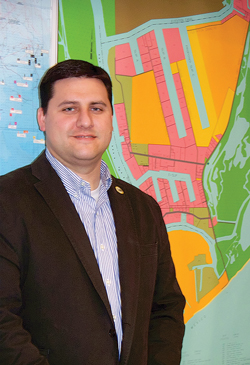|
As anyone even remotely involved in the offshore oil and gas industry can certainly attest, it has been a challenging couple of years, to say the least. Like most of these businesses, Port Fourchon made the adjustments necessary to deal with a climate filled with uncertainties. Today, however, all the signposts suggest that we have turned the corner, and that the Gulf of Mexico is returning to the business of exploring for, producing, and servicing oil and gas.
I’m proud to say that throughout this trying period, Port Fourchon has remained on schedule with our long-planned Northern Expansion program, dredging channels, building bulkhead, and creating waterfront property. This forward-thinking expansion is a testament to the commitment of the Greater Lafourche Port Commission’s leadership. We were even fortunate enough to welcome two new tenants during the past year. Although much of our attention is focused on completing the expansion and major improvements at the South Lafourche Leonard Miller Jr. Airport, we also are looking at how we can provide infrastructure and support for the industry of tomorrow.
While all the indicators suggest that the business cycle has turned the other way, with more rigs drilling, and more equipment and services being consumed, some of the uncertainties remain. Chief among these is the unacceptably slow pace of drilling permit approvals and the confusion that surrounds the process. As a member of the Gulf Economic Survival Team, or GEST, the Port continuously lends its voice to the growing choir that is urging the federal government to speed up the permitting process for the sake of jobs, energy security and the economy. We emphasize continuously that this is not an industry or southern Louisiana problem, it’s a national problem.
We often end our presentations with a slide that says, “The future of this nation’s energy stability rests in our ability to access the resources of the Gulf of Mexico.” As an intermodal hub, Port Fourchon’s accessibility lies in waterways, airways, pipelines and, of course, our main roadway, LA 1. Pre-Macondo, the main roadway leading to Port Fourchon was deemed a high-priority energy corridor by the federal government as part of the nation’s critical energy infrastructure. We have been terribly disappointed that the government is ignoring this priority by denying multiple applications for funding to elevate this vital artery. As a founding member of the LA 1 Coalition, the Port will continue in the ongoing effort to seek federal funding to complete this critical highway initiative. Although Port Fourchon is just a dot on the map to most folks, those of us who live and work here are proud to be providing energy to our nation, jobs to our citizens, and strength to our community. Port Fourchon works. Period. And we will keep working for our people, our businesses and our industry, until our voices are heard and acknowledged.—Chett Chiasson 
 |
| Port Fourchon Executive Director Chett Chiasson |
|
|



